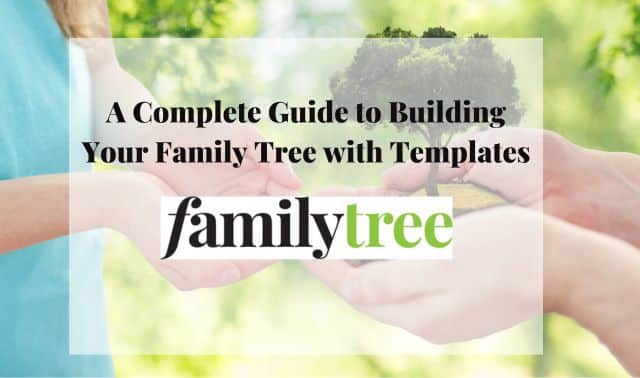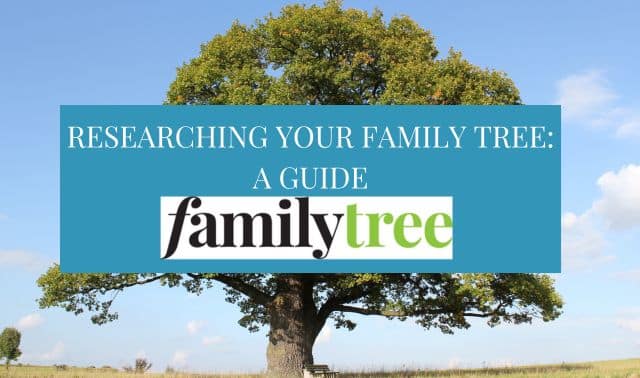Sign up for the Family Tree Newsletter! Plus, you’ll receive our 10 Essential Genealogy Research Forms PDF as a special thank you.
Get Your Free Genealogy Forms
"*" indicates required fields

Second, third, fourth and beyond cousins, who may be a generation or more “removed” from you, are a huge asset to your family history search. They may have new family information and photos that weren’t passed down through your line. They might be able to shed light on your research brick walls or lend a DNA sample.
Heck, you might even enjoy swapping stories with them at family reunions. Think about it for a minute: When your ancestors died, they passed bits of their lives on to descendants. They passed those bits on to more descendants. Gathering your cousins together is like reuniting an ancestor’s lost treasure trove of personal items and ephemera.
So the real question isn’t how many cousins you have, but how do you find them? I’ll outline 10 ideas for finding distant cousins—and all those lost treasures. And in the box on the bottom of this page, you’ll find tips for contacting those cousins. With a little hard work and some gumption, you’ll soon be making connections everywhere. Maybe you’ll discover I’m your cousin, too!
1. Frequent family tree websites.
Build-your-own-family tree websites are sprouting up everywhere. Nearly every online genealogical database site (including Ancestry.com, MyHeritage and Findmypast) has a place where you can put your tree, or add to one giant communal tree, such as FamilySearch. Some sites, such as Geni and Tribal Pages, are especially for trees; these might match your tree to records from another genealogy site.
Upload GEDCOMs
Researchers typically will pick a site they like and stick with it. But as a cousin hunter, you’re better off trying to investigate as many as you can. Some sites require you to register (whether for free or a fee) to view their trees. Typically, you must register before you can contact a tree submitter through the site. If you take the time to join a site, upload a GEDCOM (or start a fresh tree), so cousins can find you, too. One way to manage several online trees is to keep a fully fleshed out tree with notes and attached records on one site or in your software, and export a GEDCOM to post on other sites. A spreadsheet can help you keep track of where you have your tree. Periodically replace those trees with a new GEDCOM so they’ll stay updated.
I like to look through sites’ online trees and see who shares an ancestor with me. Then I attempt to make contact by starting a conversation about our common family. Most family tree sites encourage collaboration, increasing your chances that the person is open to such communications and will respond. In addition to the sites already mentioned, consider frequenting the family trees on WikiTree and OneGreatFamily.
2. Test your DNA.
Genetic genealogy is a hot topic, and researchers take DNA tests for any number of reasons. Many are curious to see what those tests will say about their ethnic roots. Someone might be looking for an adopted ancestor’s birth parents, or want to see if he’s related to another family of the same surname. Even if you’re not expressly looking for cousins when you take a DNA test, the ability to find relatives is a benefit not to be overlooked.
First, you’ll want to make sure you take the right test. A Y-DNA test, if you’re male (or if you’re a woman whose brother or father test), can match you with male cousins along paternal lines, such as your brother’s son or your father’s father’s brother’s son. But that leaves out much of your family tree. Autosomal DNA testing, which examines your entire tree along paternal and maternal lines, has the most potential to help you find close and distant cousins. It’s offered by the major genetic genealogy testing companies: AncestryDNA, FamilyTreeDNA (called the Family Finder test), MyHeritage DNA and 23andMe.
Connect with DNA matches
Your testing company will search its results database for matches and show them to you when you log into the site. Start by reaching out to your close matches—those estimated as fourth cousins and closer—so you’ll have a higher success rate in finding a common ancestor. With AncestryDNA and MyHeritage DNA, if you subscribe to each respective site, you’ll be able to view online family trees of matches who’ve posted them. If you subscribe and have a public tree on the site, you’ll be placed in “circles” with others who share an ancestor and match at least one other person.
FamilyTreeDNA also hosts group testing projects. Some of these are surname-specific, using Y-DNA to trace the heritage of surnames and variants, while others are family-specific, testing all of the descendants of one couple. These projects are great places to learn more about your family and collaborate with others who are as passionate about their family history as you are.
3. Seek surname studies.
Members of surname groups, also called one-name research groups, collaborate online to piece together the common family tree (or trees) for that surname. Their studies can show how far-flung branches are related and when and where name variants occurred. And of course, members can discover cousins from all over the world.
You’ll find more information and directories of these studies on the websites of the Surname Society and the Guild of One-Name Studies. You also can search the web for the name and “surname study” (with the quotation marks). Don’t be shy. If you don’t find a study for your surname, seize the opportunity to start one.
4. Surf social networks.
Genealogists love to share a good family story and talk about hard-to-find ancestors. That makes social media sites great places to find cousins. Facebook and Google+ have genealogy-minded groups (on Facebook) and communities (Google+) focused on members’ surnames; ancestral cities, states and countries; and just about any research topic you can think of. They’re great for cousin hunting because you share at least one thing in common from the get-go: the topic that brought you there.
You also might uncover a cousin, although it can be hard to tell if someone’s related based on just a name and the limited information you can view if you’re not linked to that person on the site. If you feel confident the person is a relative, you can send a friend request on Facebook. You also can message the person on Facebook, although the message will go into his “Message Requests” folder if you’re not friends. (Let this be a reminder to check your own Message Requests folder in case a cousin has messaged you.) Use the sites’ search boxes to look for surnames and places of interest. Results will show you matching people, pages and groups. You also can download Katherine R. Wilson’s list of genealogy groups on Facebook.
Respect and connect
When you join a group, you’ll send a request and wait to be added. Once you are, read the posting guidelines, introduce yourself and briefly say why you’re there. Share just enough information about your family tree to see if you get a cousin nibble. No cousins in the group? Another member may be able to point you the right direction.
GenealogyWise is a free, genealogy-focused social network where you can chat, create a personal page, join a group, write on a blog, watch videos, post photos and more.
Whatever social network you use, put yourself out there. Especially on the mainstream sites, make it clear in your profile that you’re a genealogist. In posts, talk about your ancestors, brick walls, finds and anything that could bring cousins to your page. Join hangouts (on Google+) and chats (on GenealogyWise) on subjects related to your family.
5. Find family forums.
Genealogy message boards now tend to play second fiddle to social networks, but they have a big advantage over their newer cousins: Whereas social media posts get pushed down and forgotten over time, your forum posting will remain easily available for others to find and respond to as long as the forum exists. A forum post of mine once took three years to get a reply, but finally the right cousin joined, and we were able to help each other knock down a brick wall. Forum posts are categorized for efficient browsing, and those that have been around for awhile, such as Ancestry.com’s, have a rich supply of stored cousin queries and hints.
Start with surnames
Forums have boards for all topics under the sun, but it’s the surname boards where you’ll find the most potential relatives. You might be able to browse to your surnames in an alphabetical directory or type a name (and the associated place, if it’s a common name) to find posts mentioning your family. If you register with the site, you can join the conversation or contact the poster by clicking on his or her username. Look for contact guidelines before messaging someone. Messaging capabilities vary by site. If you can’t get a hold of the person, try searching online for his username. You may find an email address you can use to get a hold of the person.
Of course, you also should post your own questions and queries. After the first few messages on different forums, it can be difficult to keep up with where, when and what you posted. It’s a good idea to keep a correspondence log to track your postings and replies. My log tracks posts on the Family Tree Forum.
6. Sign up for societies.
Genealogists are proud of their research, and we like to gather with like-minded individuals share information. I think this is why so many different types of societies revolve around genealogy or history. If you’re not a member of a genealogical or historical society, consider becoming a member of one from your ancestor’s county or state.
Through this group, you’ll discover new resources and meet people who not only can point your research in the right direction, but who may be related to you as well. Or because they know the area, they might be able to put you in contact with other descendants of your ancestors. (A cousin hunting two-fer!) To find a society, search online for the state, town or county plus “genealogical society” or ask at the local library.
Many societies produce newsletters and journals you’ll want to read. These wonderful resources often contain family histories, case studies and cousin queries from other members. Consider placing a query of your own. If you find an article mentioning your surnames, you may have found a potential cousin in the author. The writer might include contact information with the piece or you can contact the editor and ask that your message be passed on.
Organizations founded around a specific surname or lineage also can bring you into closer contact with potential cousins. If you qualify for an organization such as the Alden Kindred of America or the Pilgrim Edward Doty Society —each dedicated to a Mayflower pilgrim—joining virtually guarantees you’ll find distant cousins. Lineage societies with broader focus include the Daughters of the American Revolution (for those connected to Patriots), the General Society of Mayflower Descendants (for descendants of any Mayflower pilgrim) or any number of pioneer societies (for founders or early settlers of a county or state).
A good recourse for finding a society you could qualify for is a local genealogical society or the Hereditary Society Community of the United States of America.
7. Browse blogs.
Blogs are useful resources for the cousin hunter when used to their fullest potential. Why would someone post stories about his or her ancestors on a blog? To preserve those interesting tales about fascinating people for posterity, but they also want someone to contact them and say “Hey! I think we’re related.”
Often bloggers put their brick walls on the internet, hoping someday, someone who searches for that topic, person or other bit of information will have a helpful clue. Read blog posts that pop up when you search for your ancestors, and subscribe to blogs about the history of your ancestral places.
Look for a Contact or About Me link if you want to contact the blogger. Be sure to comment on posts related to your ancestral places and surnames, too. Someone else looking for the same family history details might see it.
8. Meet and greet in person.
In this age of Facebook, forums and email, we forget that some of the best connections come when you’re at a genealogy conference or class and you realize that you and the person you’re chatting with are related. That instant connection is hard to explain unless you’ve experienced it. Look for local genealogy classes and meetings through a society or at the library, and ask others about their research. Tell them about yours, too. You could write a couple of surnames you’re searching on your name tag or have business cards listing your surnames and email address. When you go to a genealogical library, ask if there’s a surname registry you can add your name to. On a research trip, particularly overseas, ask about descendants at the records office or library in your ancestors’ hometown.
9. Peruse the papers.
Not everyone left the towns and cities where their families settled. Many stayed put and grew deep, deep roots. Looking in local newspapers from today and the recent past might turn up surnames from your family tree. Check obituaries, marriage and graduation announcements, and special-interest stories. Then do a little genealogy detective work for a connection to a common ancestor. In small towns, the paper might even forward a letter to the person for you.
10. Go to reunions.
If you’ve been letting that annual family reunion invitation from second cousin Edna go ignored, do something different this year: RSVP with a yes and attend with a smile—and with copies of old family photos folks can identify. A family reunion is a great way to reconnect with your long-lost cousins and meet new ones you didn’t know you had. If you’re shy about socializing in a big, unfamiliar group, consider helping to organize the event (a good way to mingle) and go with a spouse or sibling for moral support.
If your family doesn’t have a reunion, maybe you can find one. Many large families have websites that announce when the next gathering will take place. Just search for your surnames and the associated locations plus the term “family reunion” (with quotation marks to find the exact phrase). The site may have family history information to help you determine if you’re related or you could contact the site administrator for information.
Related Reads
A version of this article appeared in the the May/June 2015 issue of Family Tree Magazine. Last updated: November 2024







